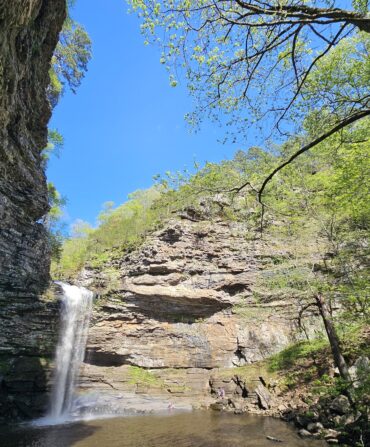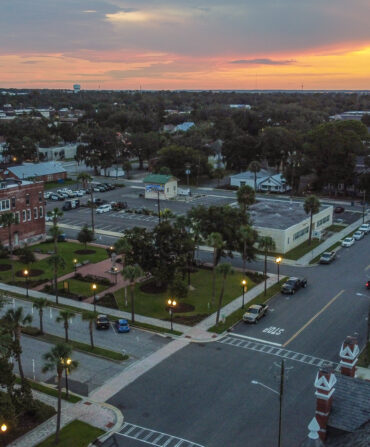In the pantheon of Southern cities, Roanoke has never been the part of Mr. Jefferson’s state known for putting on airs. (We leave that to our older and fancier cousins to the east, Richmond and Charlottesville.) We’re so friendly, in fact, that our grocery checkout clerks are apt to inquire, “What are you fixin’ with that?” But there are a couple of things you should know before you visit the Star City of the South, whether you’re toting kids, mountain bikes, or retirement community brochures.
First, don’t call us a “gritty industrial town,” as travel writers from Washington and New York inevitably do. That’s so pre-1982, the year our longtime sugar daddy, the Norfolk & Western Railway, became Norfolk Southern and sent the corporate headquarters packing to Norfolk. We love our rail heritage, as evidenced by our excellent train photography museum, named for and showcasing the images of O. Winston Link, and the railroad still has a presence here, with coal-bearing trains on the way from the coalfields to the coast, and downtown facilities that service rail engines and cars. But we’d love it more if the railroad would help bring passenger rail service back. (As it is now, you can hop a four-dollar shuttle bus to the Amtrak in Lynchburg.)

Photo: Jennifer Causey
Sally takes a snooze at Black Dog Salvage.
Second, it’s okay to make fun of our giant neon star perched atop iconic Mill Mountain in the heart of the city. The bright-white star punctuates the rolling Blue Ridge and overlooks a valley of 300,000 residents. Around the Fourth of July, they often turn it red, white, and blue. We called it tacky at first, too. Just know that, like Roanoke, the star has a way of growing on you, and before long you will be comforted by its glow. Roanoke can’t claim the state capitol or Monticello, and it’s five hours from the beach. But when the fog eclipses Mill Mountain at night, the star hovers as if suspended, a civic sentinel that nods: We’re a little different here, and we’re okay with that.
I’m not a native Roanoker, but I’ve lived here nearly half my life—long enough to incorporate “y’all” into my everyday speech but just short of ever “cutting off” the TV. Like many reporters at the Roanoke Times, I moved here shortly after graduating from college, thinking Roanoke a stepping stone to a bigger newspaper and big-city excitement. But a funny thing happened months after I landed here in 1989, at a gritty (oops) dive bar downtown: I met my husband at a David Bromberg concert and stayed. Had two kids and kept staying. Bought one house, then a bigger one. Bought so many groceries that the checkout clerk knows what I’m fixing for dinner and she knows my name.
I stayed so long that my dive bar turned into yuppie condos. In the past decade, more than 1,100 people have moved downtown, up from just 50 in 2000. They can walk to sample Thai, Indian, and upscale Southern food, and down-home chicken and waffles. There’s an open-air downtown market where farmers truck produce in from nearby hills and valleys, and, like the lady at Kroger, they also have ideas about what you’re going to fix. (Turnips roasted with olive oil and kosher salt? Who knew?)

Photo: Jennifer Causey
A puzzle in the lobby of the Hotel Roanoke.
Along Williamson Road, our growing immigrant community is on display. There’s a Mexican carniceria, Cuban- and Honduran-run establishments, and bibambap (served in a sizzling stone bowl at Wonju Korean restaurant). Thanks to Roanoke’s refugee resettlement office, there are bus stops where you can hear more than a dozen languages spoken.
I live a ten-minute bike ride from downtown in a creaky five-bedroom Foursquare that turns my big-city pals green—especially when they hear the price. Developed in the 1920s, Grandin Village is highly walkable, including to restaurants, a natural foods co-op, and an architectural salvage wonder called Black Dog Salvage that would make Fred Sanford weep, especially the non-yard-sale prices. (My husband has finally forgiven me for commissioning, sans spousal consultation, a kitchen island crafted from wrought iron, barn wood, and teak posts that are allegedly four hundred years old.)
If my eighteen-year-old drives too fast through the neighborhood or talks smack in the art-house movie theater where he works, chances are I’ll hear about it, either at my stool at the Local Roots bar (where I’m Beer Club member No. 11) or at the Saturday morning Grandin Village Community Market three blocks from my house (local food, crafts and, between me and you, bootleg bacon—if you know just whom to ask). If my fourteen-year-old fledgling bass player signs up for lessons at the Downtown Music Lab, chances are he’ll get to jam with Esperanza Spalding—seriously—when she’s passing through town. The Lab is housed at the nonprofit Jefferson Center, a performing-arts hall run by honest-to-God musicians who coax other honest-to-God musicians into mentoring young Roanokers, an exchange of creative capital and connectivity rare in bigger cities. Roanoke used to be the place artists played on their way down the career ladder. Now, thanks to an explosion of venues and a location between D.C. and Nashville, it’s a magnet for musicians on their way up.
The gritty stuff has given way to a sprawling health-care engine, Carilion Clinic, featuring a new medical school affiliated with nearby Virginia Tech. The city also touts a $66 million art museum designed by a Frank Gehry protégé. Scorned by one critic as “the wreck of the Flying Nun,” the Taubman Museum of Art is growing on us, too—though not quite enough of us, judging from its financial woes.

Photo: Jennifer Causey
Buildings along South Jefferson Street.
If you ask me, Roanoke’s star shines brightest when it elevates the authentic over the aspirational. The railroad can go to Norfolk and the textile plants to China, but folks are finally realizing that our natural amenities can’t be outsourced or outdone. A paved greenway that grows longer by the year snakes from Salem to Roanoke and Vinton, following the Roanoke River as well as the Tinker Creek made famous in the Pulitzer-winning book by Hollins University (then Hollins College) alum Annie Dillard. Visitors can rent bikes at UnderDog Bikes and ride the rare-for-Roanoke flat path past herons, wildflowers, and a former silk mill that now houses entrepreneurial upstarts like the custom teardrop camping trailer company Silver Tears.
Athletes flock here for regional bike races, such as the 103-mile-long Mountains of Misery. More doable for the casual cyclist—and a lot less miserable—are the copious regular group rides, including one called the Tuesday Night Beer Ride that winds up Mill Mountain, around the Blue Ridge Parkway, and ends downtown at—you guessed it—a bar.
My husband and I begin most mornings by walking the mutt up Mill Mountain. We’ve hiked it in rain and snow, plotting schedules and grocery lists and sussing out our worries. The city lights grow smaller as we climb, and the mournful Norfolk Southern work whistle still blows, reminding railcar makers and train engineers to go to work.
It’s late June as I write, and today we hauled home a mess of wineberries, the tarter wild cousin of the red raspberry. When we began our mountain ritual a decade ago, there were just a few wineberry patches. But the seed-dispersing birds have been busy, and this year we found the canes clustered everywhere we turned, a surprise bounty that, like the city itself, just gets juicier by the year.
I prefer my berries unadorned, by the way, with my cereal—in case you were wondering what I was going to fix.









